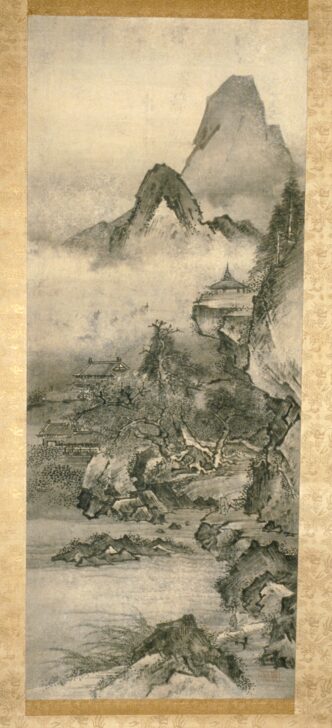Temple in the Mountains
Kanō School

Description
Kanō School 狩野派
Japan
Temple in the Mountains
Edo period (1615–1868)
17th century
Hanging scroll, ink on paper
Gift of Mr. and Mrs. Province M. Henry, 1955/1.263
In this painting, the contrast between the hard rocks—rendered
through thick brushwork—and the soft water—rendered through
lighter brushwork—embodies one of the core principles of Song
dynasty (960–1279) literati (amateur scholar-artist) painting from
China: yin and yang, or the idea that everything in nature is composed
of complementary, but opposing forces.
Further evidence of the exchange between Chinese and Japanese
literati painters is seen in the use of shifting perspective, highlighted
through the qualities of the meandering pathway. This begins in the
lower right quadrant of the painting and takes the viewer around the
edges of a shallow body of water, toward an assemblage of temple
buildings, before resting on a solitary temple in the upper half of the
composition. Along this path, an impressive array of brushwork can be
observed: the more saturated brushwork in the foreground suggests
that the shallow body of water and rocky boulders are closer to the
viewer, while the lighter wash used to render the solitary temple and
mountain peaks suggests spatial recession in the upper half of the
composition.
(Japanese Gallery Rotation, Summer 2025)
Subject Matter:
This painting depicts an imaginary scene in south China, the home of the great monasteries where several influential Japanese Zen monks studied in the fourteenth and fifteenth centuries. This painting also bears a false seal of Shûbun, one of Japan's most admired landscape painters of the fifteenth century; but in this case, the type departs radically from the elusive, dreamy quality we associate with Shûbun today.
Physical Description:
The composition is a well-established type: a complex of temple buildings is tucked into a mountainside, on the shore of a broad body of water, with mists rising to obscure the distant peaks. The artist provides a path leading from the viewer’s space to the temple. Two travelers go before us, a hooded figure riding a donkey over a rustic bridge, and another man striding along on foot, further ahead. The temple buildings themselves are hidden behind thick foliage, as if protected from the secular world.Here the forms of the rocky outcroppings, the trees, and even the mountains are starkly outlined, and there are strong contrasts of light and dark. These features suggest that this is a work of by a professional Kanô School artist, probably of the seventeenth century.
Usage Rights:
If you are interested in using an image for a publication, please visit https://umma.umich.edu/request-image/ for more information and to fill out the online Image Rights and Reproductions Request Form.